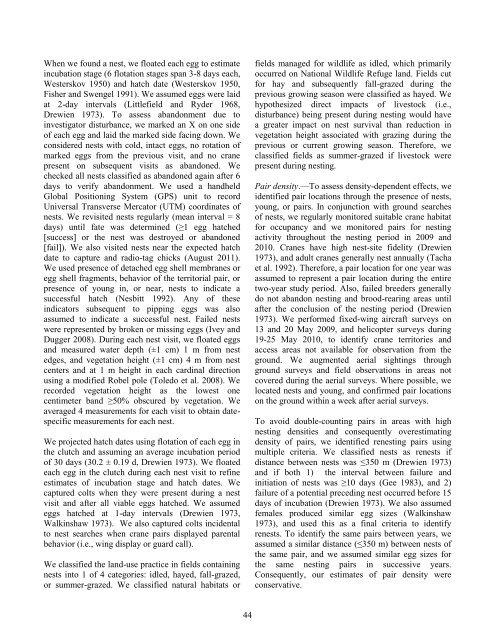Webless Migratory Game Bird Program - U.S. Fish and Wildlife Service
Webless Migratory Game Bird Program - U.S. Fish and Wildlife Service
Webless Migratory Game Bird Program - U.S. Fish and Wildlife Service
You also want an ePaper? Increase the reach of your titles
YUMPU automatically turns print PDFs into web optimized ePapers that Google loves.
When we found a nest, we floated each egg to estimate<br />
incubation stage (6 flotation stages span 3-8 days each,<br />
Westerskov 1950) <strong>and</strong> hatch date (Westerskov 1950,<br />
<strong>Fish</strong>er <strong>and</strong> Swengel 1991). We assumed eggs were laid<br />
at 2-day intervals (Littlefield <strong>and</strong> Ryder 1968,<br />
Drewien 1973). To assess ab<strong>and</strong>onment due to<br />
investigator disturbance, we marked an X on one side<br />
of each egg <strong>and</strong> laid the marked side facing down. We<br />
considered nests with cold, intact eggs, no rotation of<br />
marked eggs from the previous visit, <strong>and</strong> no crane<br />
present on subsequent visits as ab<strong>and</strong>oned. We<br />
checked all nests classified as ab<strong>and</strong>oned again after 6<br />
days to verify ab<strong>and</strong>onment. We used a h<strong>and</strong>held<br />
Global Positioning System (GPS) unit to record<br />
Universal Transverse Mercator (UTM) coordinates of<br />
nests. We revisited nests regularly (mean interval = 8<br />
days) until fate was determined (≥1 egg hatched<br />
[success] or the nest was destroyed or ab<strong>and</strong>oned<br />
[fail]). We also visited nests near the expected hatch<br />
date to capture <strong>and</strong> radio-tag chicks (August 2011).<br />
We used presence of detached egg shell membranes or<br />
egg shell fragments, behavior of the territorial pair, or<br />
presence of young in, or near, nests to indicate a<br />
successful hatch (Nesbitt 1992). Any of these<br />
indicators subsequent to pipping eggs was also<br />
assumed to indicate a successful nest. Failed nests<br />
were represented by broken or missing eggs (Ivey <strong>and</strong><br />
Dugger 2008). During each nest visit, we floated eggs<br />
<strong>and</strong> measured water depth (±1 cm) 1 m from nest<br />
edges, <strong>and</strong> vegetation height (±1 cm) 4 m from nest<br />
centers <strong>and</strong> at 1 m height in each cardinal direction<br />
using a modified Robel pole (Toledo et al. 2008). We<br />
recorded vegetation height as the lowest one<br />
centimeter b<strong>and</strong> ≥50% obscured by vegetation. We<br />
averaged 4 measurements for each visit to obtain datespecific<br />
measurements for each nest.<br />
We projected hatch dates using flotation of each egg in<br />
the clutch <strong>and</strong> assuming an average incubation period<br />
of 30 days (30.2 ± 0.19 d, Drewien 1973). We floated<br />
each egg in the clutch during each nest visit to refine<br />
estimates of incubation stage <strong>and</strong> hatch dates. We<br />
captured colts when they were present during a nest<br />
visit <strong>and</strong> after all viable eggs hatched. We assumed<br />
eggs hatched at 1-day intervals (Drewien 1973,<br />
Walkinshaw 1973). We also captured colts incidental<br />
to nest searches when crane pairs displayed parental<br />
behavior (i.e., wing display or guard call).<br />
We classified the l<strong>and</strong>-use practice in fields containing<br />
nests into 1 of 4 categories: idled, hayed, fall-grazed,<br />
or summer-grazed. We classified natural habitats or<br />
44<br />
fields managed for wildlife as idled, which primarily<br />
occurred on National <strong>Wildlife</strong> Refuge l<strong>and</strong>. Fields cut<br />
for hay <strong>and</strong> subsequently fall-grazed during the<br />
previous growing season were classified as hayed. We<br />
hypothesized direct impacts of livestock (i.e.,<br />
disturbance) being present during nesting would have<br />
a greater impact on nest survival than reduction in<br />
vegetation height associated with grazing during the<br />
previous or current growing season. Therefore, we<br />
classified fields as summer-grazed if livestock were<br />
present during nesting.<br />
Pair density.—To assess density-dependent effects, we<br />
identified pair locations through the presence of nests,<br />
young, or pairs. In conjunction with ground searches<br />
of nests, we regularly monitored suitable crane habitat<br />
for occupancy <strong>and</strong> we monitored pairs for nesting<br />
activity throughout the nesting period in 2009 <strong>and</strong><br />
2010. Cranes have high nest-site fidelity (Drewien<br />
1973), <strong>and</strong> adult cranes generally nest annually (Tacha<br />
et al. 1992). Therefore, a pair location for one year was<br />
assumed to represent a pair location during the entire<br />
two-year study period. Also, failed breeders generally<br />
do not ab<strong>and</strong>on nesting <strong>and</strong> brood-rearing areas until<br />
after the conclusion of the nesting period (Drewien<br />
1973). We performed fixed-wing aircraft surveys on<br />
13 <strong>and</strong> 20 May 2009, <strong>and</strong> helicopter surveys during<br />
19-25 May 2010, to identify crane territories <strong>and</strong><br />
access areas not available for observation from the<br />
ground. We augmented aerial sightings through<br />
ground surveys <strong>and</strong> field observations in areas not<br />
covered during the aerial surveys. Where possible, we<br />
located nests <strong>and</strong> young, <strong>and</strong> confirmed pair locations<br />
on the ground within a week after aerial surveys.<br />
To avoid double-counting pairs in areas with high<br />
nesting densities <strong>and</strong> consequently overestimating<br />
density of pairs, we identified renesting pairs using<br />
multiple criteria. We classified nests as renests if<br />
distance between nests was ≤350 m (Drewien 1973)<br />
<strong>and</strong> if both 1) the interval between failure <strong>and</strong><br />
initiation of nests was ≥10 days (Gee 1983), <strong>and</strong> 2)<br />
failure of a potential preceding nest occurred before 15<br />
days of incubation (Drewien 1973). We also assumed<br />
females produced similar egg sizes (Walkinshaw<br />
1973), <strong>and</strong> used this as a final criteria to identify<br />
renests. To identify the same pairs between years, we<br />
assumed a similar distance (≤350 m) between nests of<br />
the same pair, <strong>and</strong> we assumed similar egg sizes for<br />
the same nesting pairs in successive years.<br />
Consequently, our estimates of pair density were<br />
conservative.

















